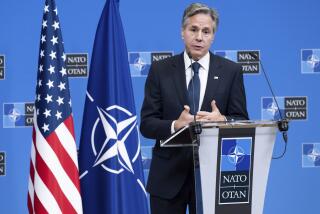As Continental Rift Mends, a Pan-European Identity Requires U.S. Adjustments
The great gash that has split Europe between East and West is healing, with political effects for Washington and Moscow as well as for Europe itself.
More than 300,000 Poles visited West Germany and West Berlin during 1988. During one single holiday weekend last month, a quarter of a million Hungarians came to Vienna to shop--producing a Viennese joke that Hungarians no longer want help seeking refuge, but to lift their appliances onto their cars. That was before Hungary began tearing down its border fence.
European Community officials speak of a new Marshall Plan to help revive the East European economies. France, Great Britain and West Germany are vying for influence in Eastern Europe. One reason the West German public opposes nuclear missiles is to avoid threatening East Germany and Poland.
These are not isolated events, but elements of a new and powerful trend: The gradual mending of the European rift and the reawakening of pan-European consciousness.
By the same token, a resurrected Europe also may offer another solution familiar to European history: A German framework that separates German political and national identities. As contacts between the two German states expand, they are increasingly reminiscent of earlier arrangements, such as the Holy Roman Empire or the German Confederation, under which German states of diverse and even opposite political, religious or social systems were linked under a broad umbrella while remaining separate. Those arrangements did not then fully satisfy German national aspirations, and may not do so now, but they reassured their neighbors and provided a European core open in both directions.
This may ultimately be the essence of a European solution: The borders remain but their functions change; the armies remain but their weapons and postures change.
Soviet President Mikhail S. Gorbachev understands the new trend toward a reunited Europe and exploits it. His “common European house” proposals appeal to deep-seated feelings. He tried at first to exclude the United States, but the Europeans--especially the West Germans--insisted on an American role.
Nonetheless, the revival of European consciousness can pose a problem for Washington. The United States has not had a durable relationship with a Europe at peace. America came to Europe in two world wars and remained during the Cold War. All too often, military considerations have dominated U.S. thinking.
U.S. policy needs to adjust as Europe evolves and redefines its identity. The U.S. presence will need restructuring. One reason for the German-American dispute about missile modernization and negotiations is that we have not taken account of some of the changes in Europe.
The United States should not retreat from Europe, especialy after it has achieved its original goals, but it has to find a presence that corresponds to the emerging pan-European identity, to a reduced but potentially revivable Soviet threat, and to the long-term U.S. national interest. And it must begin to define its role soon, before it seems to be opposing the forces at work on the continent.
Washington and its partners in the Atlantic Alliance have not yet begun to consider how to preserve the essential strategic, political and economic relationship between Western Europe and the United States under new circumstances. But neither we nor the West Europeans can continue to delay such consideration, and the NATO summit next week is as good a place as any to begin.
More to Read
Sign up for Essential California
The most important California stories and recommendations in your inbox every morning.
You may occasionally receive promotional content from the Los Angeles Times.










